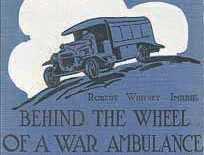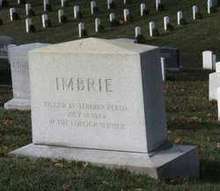Robert Whitney Imbrie
Robert Whitney Imbrie (April 23, 1883 – July 18, 1924) was the first United States Foreign Service officer to be assassinated. He was murdered in Tehran, Iran while serving on temporary assignment. [1]
.jpg)
Early years
Imbrie was born in Washington, D.C. on April 23, 1883. He was the only surviving child of Jeremiah and Leila (Whitney) Imbrie. His mother died when he was seven; his father when he was thirteen. Imbrie then came under the care of his maternal aunt and her husband, Mary O. and Charles Fishbaugh.[2]
Imbrie attended Friends Select School, Central High School, George Washington University, (A.B. 1902; LL.B. 1905) and Yale Law School (LL.M. 1906).[3] The topic of his master’s thesis was admiralty law. In 1907 he was appointed attorney-in-charge of the Seaman’s Branch of the Legal Aid Society in New York City. [4]In 1908, Imbrie opened a law practice in Baltimore with Howard McCormick, who later served as a long-time professor of English at the United States Naval Academy.[5]
Imbrie traveled extensively between 1906 and 1915, visiting the southwest U.S., Canada, Europe, and Gabon, West Africa. His guide to Africa was Richard Lynch Garner, who had been assigned by William Temple Hornaday, the director of the New York Zoological Society, to bring back a live gorilla, which he did.[6]
World War I

In late 1915 Imbrie enrolled as a volunteer driver in the American Ambulance Field Service, in service to the French Army.[7] He served in France from December 1915 until October, 1916, when he transferred to the Army of the Orient in Macedonia. He served there until April 1917, when the United States entered the war.
Imbrie received the following medals for his wartime service—the Croix de Guerre, the White Rose Croix de Guerre, the Ambulance Medal, the Field Service Medal, and the Medal of Recognition for serving six months or more at the front.[8] He was one of the longest-serving volunteer ambulance drivers in the war.
Russia
Because of his age and a recent bout with typhus, Imbrie could not enlist in the U.S. military; instead he joined the U.S. Consular Service and was sent to Petrograd. He arrived in November, 1917, in the midst of the Russian Revolution.[9]
With the Treaty of Brest-Litovsk about to be signed, ending the war between Germany and Russia, the American legation moved north in late February, 1918. In April Ambassador David Francis sent Imbrie back to Petrograd, where he stayed for five months as the primary and at times the sole U.S. representative in the city.[10] On August 30, Imbrie learned of his imminent arrest. With the help of the Norwegian embassy, he secured false papers and transportation out of the country.
Finland
In early 1919, Imbrie, now based in Viborg, Finland, began tracking the movement of the northern division of the White Army as it prepared to seize Petrograd and Moscow from the Bolshevik Red Army.[11] In addition, Imbrie worked to provide food relief to thousands of Russian émigrés.[12] After the fall of the White Army in the north, he left Finland in June 1920. By then he had been tried in absentia by the Bolsheviks and sentenced to death.[13]
Turkey
Imbrie was next posted to Crimea, where the southern division of the White Army was active; however, when he arrived in December, 1920, he found it, too, had collapsed. Instead, he was assigned to Constantinople under Admiral Mark Bristol, who headed the U.S. military and diplomatic missions in Turkey.[14] After traveling extensively throughout the region doing reconnaissance, Imbrie left Turkey in July, 1921.
Returning to Turkey in March, 1922, Imbrie became the only U.S. official observer in Angora (Ankara), the seat of the new government of modern Turkey. There he met Katherine Helene Gillespie (1883–1968), an American relief worker caring for orphans of war and genocide. They married on December 26, 1922.[15] Imbrie continued his reconnaissance work, befriended Mustapha Kemal, the new president of Turkey, and tracked American commercial interests in the area. In 1923, after Imbrie learned that a $40,000 bounty had been placed on his head, he and Katherine returned to the United States.[16] On the way they stopped in Switzerland so Imbrie could brief the U.S. representative at the Lausanne Peace Conference regarding oil concessions in Turkey.[17]
Persia
Imbrie’s next post was to Tabriz, Persia (Iran); however, before assuming that duty, he was temporarily reassigned to Tehran when Consul Bernard Gotlieb went on leave.[18] Imbrie immediately immersed himself in this new post as Persia struggled with both internal strife, involving politics and religion, and external pressures, including oil interests and foreign entanglements.[19]
Murder

On July 18, 1924, while visiting a bazaar, Imbrie was set upon by a mob and fatally beaten near the Cossack parade grounds and in the police hospital where the mob had pursued him. [20] Immediately after Imbrie's death, Prime Minister Reza Khan, soon to be Reza Shah, declared martial law.[21]
Imbrie's body was shipped home aboard the USS Trenton, the first U.S. battleship to enter the Persian Gulf,[22] and was buried in Arlington Cemetery.[23] Among the notables attending his services was President Calvin Coolidge.[24]
Aftermath
The U.S. State Department and especially the consulate in Tehran worked to bring the guilty parties to justice. However, when three people were executed, two teenagers and an army private, U.S. officials believed that justice had failed.[25] Meanwhile Imbrie's widow sought what she considered adequate indemnity for her husband's death, a legal battle that lasted for over 25 years. In 1950 the $70,000 indemnity that Persia had paid the United States was folded into a fund to educate foreign students. [26]
References
- Michael Zirinsky. "Blood, Power, and Hypocrisy: The Murder of Robert Imbrie and American Relations with Pahlavi Iran, 1924" International Journal of Middle East Studies (1986) Available at: http://works.bepress.com/michael_zirinsky/2/
- Boyd Vincent Imbrie, Mary E. Philbrook, and Addison Murray Imbrie, Genealogy of the Imbrie Family of Western Pennsylvania: Descendants of James Imbrie, Pioneer Settler and his Wife Euphemia Smart, Pittsburgh, PA: D.H. Lucas Co., 1953.
- Robert Imbrie, Application for Appointment to the United States Consulate, Imbrie Personnel File, August 14, 1917.
- .Smithsonian Museum Acquisition #98,532, received from Katherine Imbrie, 1927.
- Yale University Obituary Record of Graduates Deceased During the Year Ending July 1, 1925, Bulletin of Yale University Twenty-First Series, #22, August, 1925, 1555-1556
- Jeremy Rich, Missing Links: The African and American Worlds of R. L. Garner, Primate Collector. Series: Race in the Atlantic World, 1700-1900, Athens, GA: University of Georgia Press, 2012.
- Robert Imbrie, Behind the Wheel of an Ambulance, New York: Robert M. McBride & Cp., 1918.
- Field Service Bulletin, September 1, 1917, #9 notes Imbrie’s receiving the Croix de Guerre. For a list of Imbrie’s wartime awards, see “State Department Begins Inquiry,” The New York Times, July 20, 1924, 1
- Imbrie, "Report on the Petrograd Consulate, April 5 to September 1, 1918," RG 59 123.813/7 ½
- Imbrie, "Report on the Petrograd Consulate, April 5 to September 1, 1918," RG 59 123.813/7 ½.
- Imbrie to the Secretary of State, “Establishment of Consular Office at Viborg, Finland,” March 21, 1919, 125.972/1.
- Imbrie report of March 4, 1919 included in 861.00/4020, March 11, 1919 from Acting Secretary of State Polk to the Commission to negotiate Peace regarding the proposal of Dr. Fridtjof Nansen for Relief of Russia under Supervision of Northern Neutrals. FRUS/Russia/1919, 98.
- John W. Davis (London) to the Secretary of State. March 1, 1921. Enclosure: “Confidential Memorandum on British Counter-Revolutionary Activities in Russia” by Z. M. Kennedy submitted February 21, 1921. RG 165, Entry A1 65, MIS Correspondence, Folder 9771-245, Box 2192.
- Charles Allen to Secretary of State, December 6, 1920, Box 1448, 123 Im ¼.
- "Wedded in Constantinople: Miss Gillespie Relief Worker, Bride of Robert Imbrie of Baltimore," New York Times, December 31, 1922, 2.
- Blake to Carr, June 23, 1923,123 Im 1/82.
- Secretary of State to Turkey (Bristol), May 22, 1923, Im 1/61
- Imbrie in U.S., January 21, 1924, 123 Im 1/75.
- Imbrie Report, RG 59, 891.6363-SO/370, June 11, 1924.
- Kornfeld to Secretary of State, July 27, 1924, post mortem enclosure.
- Imperial Legation of Persia, Washington D.C. to Grew, Acting Secretary of State. July 21, 1924. Enclosure, 123 Im 1/97.
- Fuller dispatch 51 August 30, 1924, 123 Im 1/279.
- R. K. Cravens, Adjutant General's Office, War Department to Division of Near Eastern Affairs, September 25, 1924, 123 Im 1/268. Also see www.findagrave.com.
- "Coolidge Attends Imbrie's Funeral," New York Times, September 30, 1924, 12.
- Sherman Miles report, 123 Im1/290, August 31,1924, Murray telegram 645, 123 Im 1/229, August 31, 1924; Murray telegram 118, 123 Im 1/249, September 13, 1924; Murray to Secretary of State, dispatch 645, 123 Im 1/313, September 16, 1924.
- 96 Cong. Rec. 15080 1950, 15080—15088. H. R. 5731 and an identical bill, S. 2342.
External links
Susan M. Stein. On Distant Service: The Life of the First U.S. Foreign Service Officer to be Assassinated. Lincoln, NE: Potomac Books, an imprint of The University of Nebraska Press, 2020.
www.robertimbrie.com